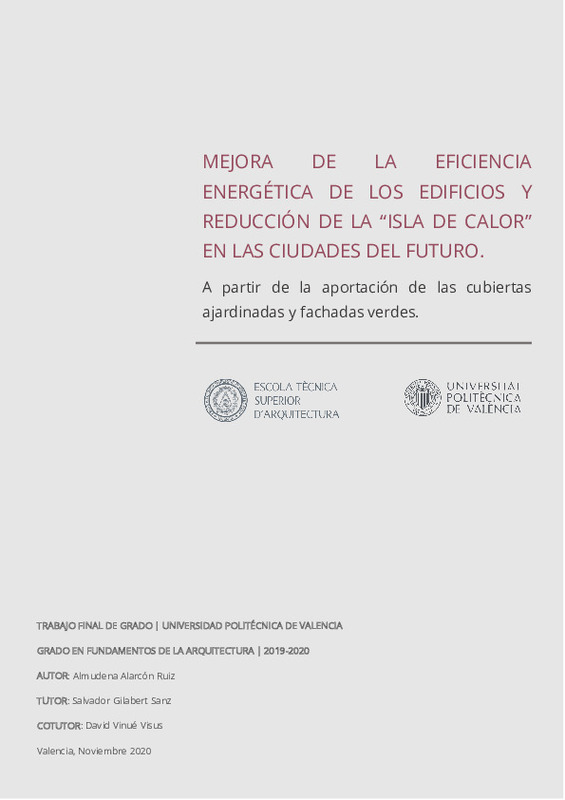|
Resumen:
|
[ES] En el presente trabajo se aborda el análisis del efecto “isla de calor”en las grandes ciudades. En concreto, se centraliza el problema en la ciudad de Valencia mediante el análisis de la temperatura superficial de ...[+]
[ES] En el presente trabajo se aborda el análisis del efecto “isla de calor”en las grandes ciudades. En concreto, se centraliza el problema en la ciudad de Valencia mediante el análisis de la temperatura superficial de diferentes tipologías decubiertas existentes en lugar. Se relaciona este hecho con la sustitución de estas cubiertas por cubiertas vegetales en estos lugares, lo que lleva a una posible solución para la mitigación del cambio climático mediante una arquitectura más sostenible. Se estudia la forma de representación gráficade las termografías y su aplicación en la arquitectura para la sostenibilidad. Así pues, parte del estudio de la temperatura superficial de las cubiertas mediante dos sistemas: el Satélite Landsat y toma de datos mediante cámara termográfica, concretamente con el modelo Flir Vue Pro.En primer lugar, se recogen datos en cuatro tipos de cubiertas, cubierta tradicional en edificio de viviendas plurifamiliar, cubierta ajardinada y cubierta de teja pertenecientes a una misma vivienda unifamiliar sostenible, y por último, cubierta de grava, perteneciente a la Escuela Técnica Superior de Arquitectura de Valencia. Además se caracterizan y representan los materiales y sistemas constructivos utilizados en estos tipos. Seguidamente, recogen y analizan datos obtenidos mediante teledetección con imágenes del satélite Landsat-8; por otro lado, se recogen datos de temperatura mediante trabajo de campo con una cámara termográfica en diversas cubiertas de varios edificios y se contrastan con los obtenidos por el satélite en condiciones muy similares. Finalmente, se explica la metodología seguida en el proceso y se exponen una serie de conclusiones obtenidas en el estudio. Analizando los resultados obtenidos y el estudio bibliográfico realizado, se llega a la conclusión de que una sustitución de las cubiertas tradicionales actuales porcubiertas ajardinadas, podría conllevar una reducción considerable del efecto “isla de calor” en las ciudades del futuro, sin embargo este proceso debería realizarse a gran escala para crear una zona ajardinada elevada de gran envergadura que fuera capaz de mitigarlas emisiones de las actuales cubiertas al medio ambiente.
[-]
[EN] In this work, the analysis of the "heat island" effect in large cities is addressed. Specifically, the problem is centralized in the city of Valencia by analyzing the surface temperature of different types of roofs ...[+]
[EN] In this work, the analysis of the "heat island" effect in large cities is addressed. Specifically, the problem is centralized in the city of Valencia by analyzing the surface temperature of different types of roofs existing in that place. This issue is related to the replacement of these roofs by green roofs in these places, which leads to a possible solution for the mitigation of climate change through a more sustainable architecture.
It starts with the study of the visual representation of thermal images and its application to green architecture. In addition to the study of the surface temperature of the roofs through two systems: the Landsat Satellite and data collection with a thermographic camera, specifically with the Flir Vue Pro model.
Firstly, data is collected in four types of roofs: traditional roof in a multi-family housing building, garden roof and tile roof belonging to the same sustainable family dwelling, and finally, gravel roof, belonging to Escuela Técnica Superior de Arquitectura de Valencia. Moreover, materials and construction systems used in these roof types are characterized and represented.
Next, data obtained through remote sensing with Landsat-8 satellite images are collected and analyzed; temperature data are collected through field work with a thermographic camera on several roofs of many buildings and are contrasted with those obtained by the Landsat Satellite in similar conditions.
Finally, the methodology followed in the process is explained and a series of conclusions obtained in this study are presented.
Analyzing the results obtained and the bibliographic study carried out, it is concluded that the substitution of the current traditional roofs by landscaped roofs could entail a considerable reduction of the "heat island" effect in the cities of the future. However, this process should be carried out on a large scale in order to create an elevated landscaped area of great importance that would be able of mitigating the emissions of the current roofs into the environment.
[-]
|








